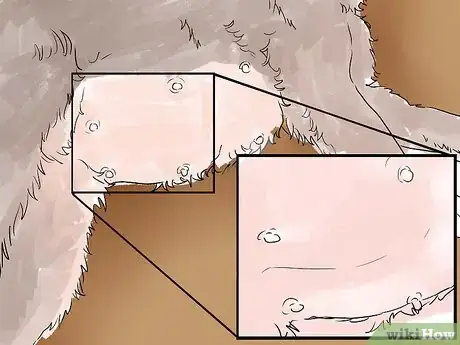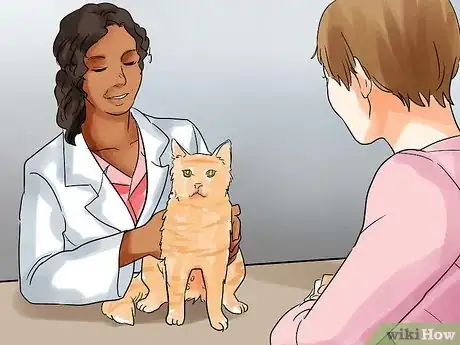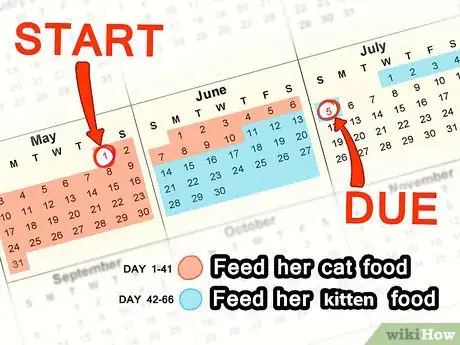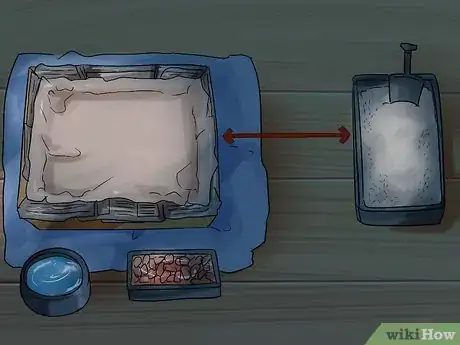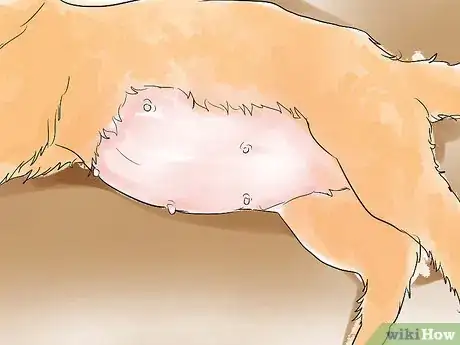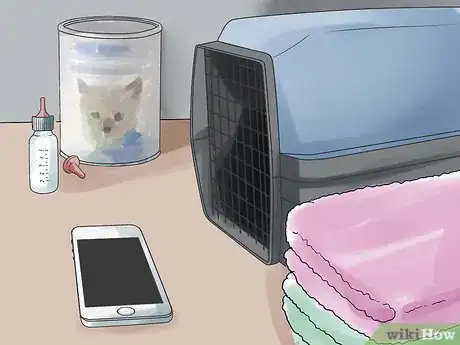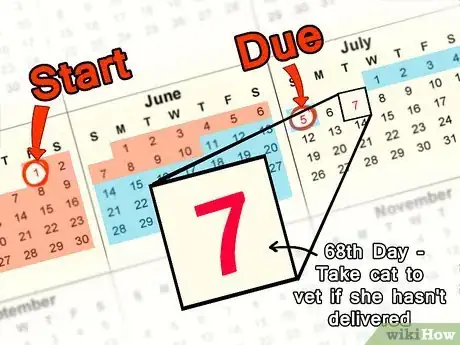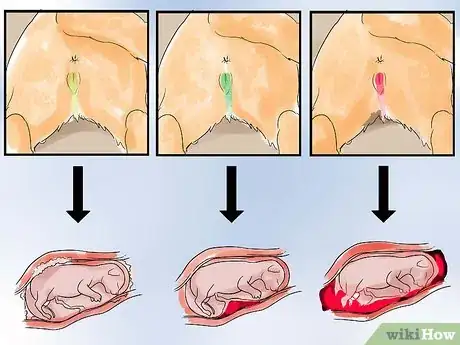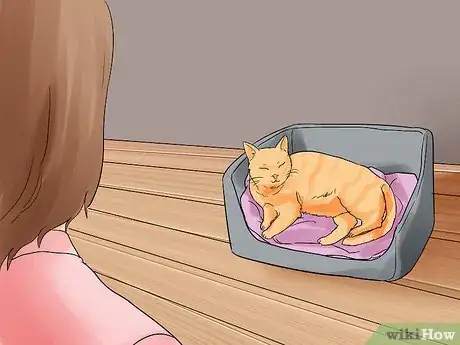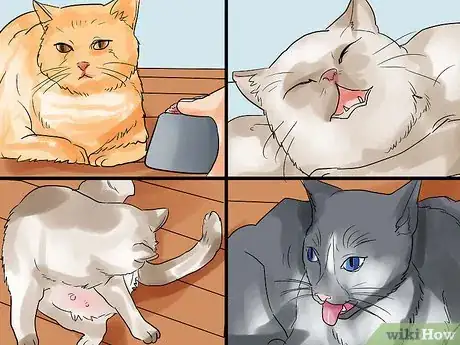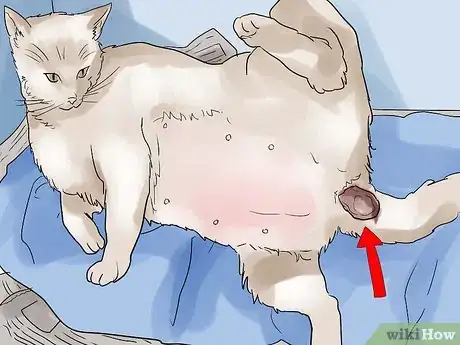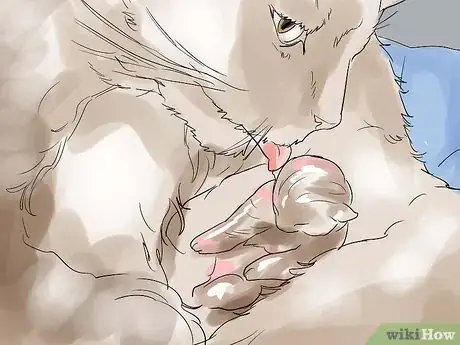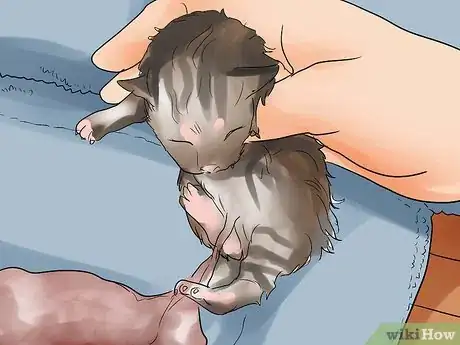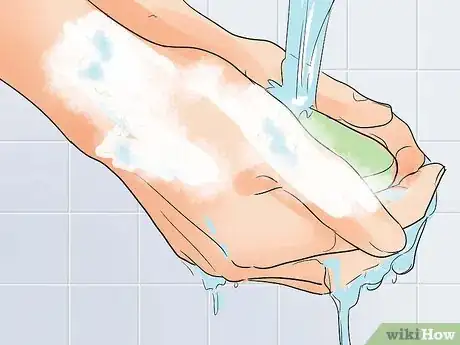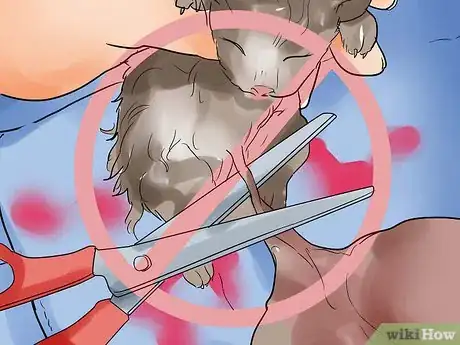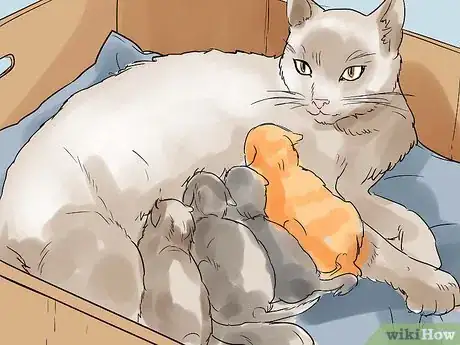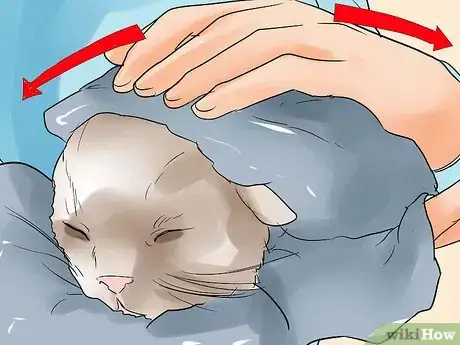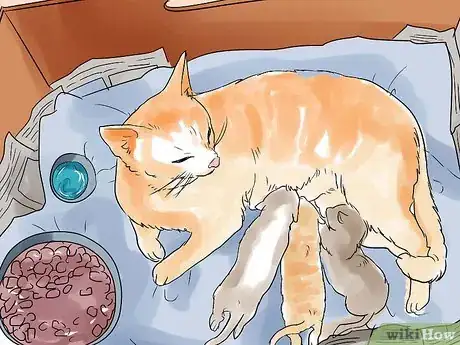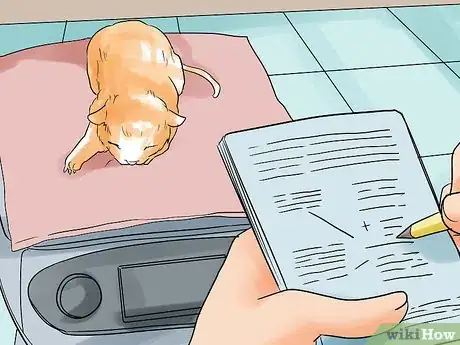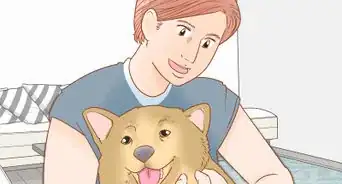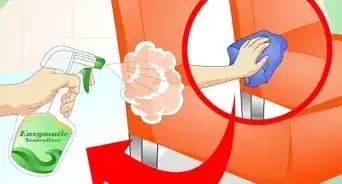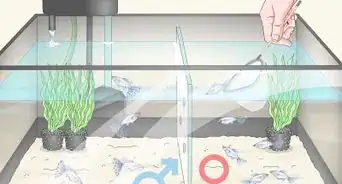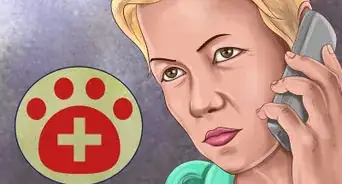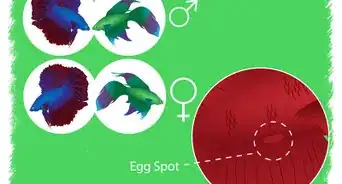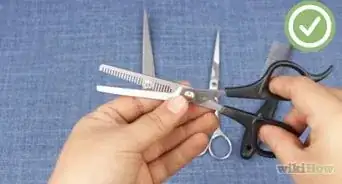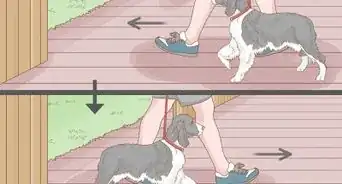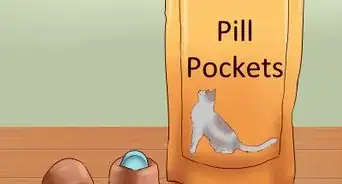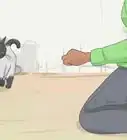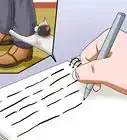This article was co-authored by Pippa Elliott, MRCVS. Dr. Elliott, BVMS, MRCVS is a veterinarian with over 30 years of experience in veterinary surgery and companion animal practice. She graduated from the University of Glasgow in 1987 with a degree in veterinary medicine and surgery. She has worked at the same animal clinic in her hometown for over 20 years.
wikiHow marks an article as reader-approved once it receives enough positive feedback. This article received 29 testimonials and 95% of readers who voted found it helpful, earning it our reader-approved status.
This article has been viewed 1,083,679 times.
Whether you are breeding purebred cats for a living or you are responsible for a cat that has become pregnant in your care, it is important to know what to do when the cat goes into labor and begins to give birth to her kittens. The typical gestation period for cats is around 65-67 days, so once you have confirmation that your cat is pregnant, it's important to begin preparing for the eventual birthing. Here is how to do so.
Steps
Preparing for Labor
-
1Look for signs of pregnancy. There are several signs you can look for to help you discern if your cat is or might be pregnant.[1]
- Common signs of pregnancy in cats are pink, enlarged nipples, a swollen belly, and an end to mating calls.
-
2Take her for a check-up. Once you know your cat is pregnant (or if you suspect that she may be), take her to a licensed veterinarian for a medical check-up.
- The vet can verify that the pregnancy is advancing without complications and can advise you on how to prepare for the birth of the kittens.
- It's particularly important to take a cat who is overweight or has pre-existing health problems to see a vet as soon as you're aware of or suspect pregnancy, as she will be more at risk for complications.[2]
- In some instances, the vet may determine that continuing the pregnancy could endanger the mother and that spaying her at this stage is the best and most humane way to proceed.
- The vet can also estimate how many kittens to expect, which will be useful later to determine when all of the kittens have been delivered and labor should be over.[3]
-
3Adjust her diet in the third trimester. When a pregnant cat reaches her third trimester (approximately 42 days into the pregnancy or when her belly is visibly swollen), she will have different nutritional needs, so be sure to make sure she's getting the proper amount of food and nutrients.[4]
- Keep her on her usual diet for the first two thirds of the pregnancy.
- For the final trimester, switch her to kitten food, which is higher in calories for a smaller volume of food. Because her womb will be pressing against her stomach, it will limit her ability to eat, so kitten food is ideal for keeping her nourished.
-
4Set up a nest. Cats need a warm, calm, safe place to give birth, and your cat will deliberately seek out such a place prior to giving birth. Your cat will usually display nesting signs several days before the birth is imminent, and this is the perfect opportunity to direct her to the nest that you have already prepared for her.
- The laundry room or a bathroom are great places to set up a nest for her; just ensure that no kids or dogs are rushing through this spot at any time. The mother must feel safe and relaxed in her nesting area.
- She should have easy access to fresh water, a little bit of food, and the litter box (which should be about two feet away - putting it too close can increase the chance of disease).
- Find a large cardboard box with high sides and fill it with old, soft things you won't mind getting soiled, like towels, fluffy blankets, newspapers, etc.
- Whatever material you decide on, it shouldn't have any strong scents, since the mother and kittens recognize each other by smell.
-
5Prepare your cat for the birth. Continue feeding her high quality food and watch for a noticeable reduction in appetite, which is usually a sign that labor is imminent.
- If you have a long-haired cat, you may wish to consider cutting the hair away from around the vulval region in advance (a few days or a week before birth). Some people also advise clipping long hair away from the nipples to assist the kittens in feeding.[5]
- If you can't trim your cat ahead of time, however, don't do it at all, as it could interfere with the kittens recognizing the mother's natural smell after they're born.
-
6Prepare yourself for the birth. In addition to having the nesting box, food, water, and litter box set up for your cat, you should also have materials ready for you to use in case of emergency.
- Keep a cat carrier nearby to use in case there are complications and she needs to be transported to the vet.
- Keep your cell phone charged and have the number to your vet and a pet hospital nearby or programmed into your phone in case she experiences complications during the birthing.
- Have a pile of clean dry towels ready in case they're needed for cleaning off the kittens.
- Buy cat-milk powder appropriate for kittens and a kitten-fostering bottle from your local pet supply store to have on hand in case there's a problem nursing the kittens. Look for "KMR" or kitten milk replacer.[6]
-
7Keep track of the pregnancy's duration. There is leeway in the length of pregnancy, particularly because it can sometimes be difficult to know the precise conception date, but a cat going over 67 days should be professionally checked.[7]
- The vet may scan her tummy to check the kittens are healthy, and then suggest giving an extra four to five days. If the kittens have not appeared in that time then a caesarian may be necessary.[8]
-
8Watch for warning signs of complications. Warning signs to watch for include abnormal discharge or illness.[9]
- Abnormal discharge: A discharge from the cat's vulva is not normal during pregnancy. A green-yellow discharge can indicate a womb infection, a bright green discharge can hint at placental separation, and a bloody discharge a placental rupture. If you see any of these signs, contact your vet immediately.
- Illness: Pregnancy places a stress on the body and can weaken the immune system. If the mother seems unwell (vomiting, diarrhea, coughing, sneezing, lack of appetite), then get her checked by the vet.
Assisting During Labor
-
1Keep some distance. Accept that for the most part your cat will not need you. Your presence in the area, though, will probably reassure her.
- Stay far enough away not to invade her space or impede the birthing, but stay close enough to intervene if necessary.
- Be prepared for possible complications and know what the signs are.
-
2Know the signs of labor. Familiarize yourself with the signs that usually indicate your cat is going into labor. Going into labor is generally known as Stage 1, and will last between 12 and 24 hours. Signs to watch for include:[10]
- Listlessness or restlessness, looking for a place to hide (show her the nest)
- Grooming excessively, including licking her vulva
- Pacing and panting
- Purring and crying loudly
- A temperature drop of about a point or two from the normal 102ºF/38.9ºC
- Ceasing to eat
- Vomiting
- If you discover that your cat is discharging blood, immediately seek veterinary assistance. Bleeding prior to labor is typically a warning that something is wrong and means you should get her immediate veterinary attention.
-
3Clean and sterilize your hands just in case you need to assist. Remove your wrist watch and rings and clean your hands with anti-microbial hand soap. Rub the soap on the backs of your hands and just past your wrist. The soap should be on your hands for at least 5 minutes with you rubbing the whole time. Use a nail brush or an old toothbrush to get under your fingernails.
- Do not use hand sanitizer! It doesn't do a thorough job of killing all the germs, and you do not want the queen licking the ingredients in hand sanitizer off the kittens, as it could make her sick.
- Hand washing is precautionary and the queen should be allowed to take care of the birthing process and kittens on her own. Only intervene if a kitten is in distress, and then return the kitten as soon as possible.
-
4Keep an eye on each delivery. Once the mother enters her nesting box and labor commences, the best thing you can do is to keep calm, be prepared, and keep watch over the deliveries. Be sure to keep both yourself and the environment around her calm. If there are any disturbances or animals around, or if she is moved to a strange place, she will delay labor. When the next stage of birth, Stage 2, is about to begin, it will typically develop as follows:[11]
- The cervix starts to relax and the queen begins uterine contractions.
- There's a build-up in contractions as the first kitten enters the birth canal. Contractions should be at 2 - 3 minute intervals and the mother will probably be in a crouched position. She may cry out and pant.
- The amniotic fluid (water bubble) comes through first, followed by the kitten (either head first or rear paws first).
- Once Stage 2 of the labor commences, it will last about 30 minutes to an hour and then the first kitten should be born. Each subsequent kitten will be about half an hour apart, sometimes up to an hour.
- If your cat has settled down and has been pushing hard without a kitten emerging for longer than an hour, it's likely a sign of a problem. Look to see if there is anything at the vulva lips. If there is nothing, then it's best to contact the vet. If a kitten is partially out, let her push for another 5 minutes. If she has made no progress, wash your hands, and gently grasp the part of the kitten you can see and pull gently - preferably in time to the queen's contractions. If the kitten does not slide out easily, contact the vet.[12]
-
5Ensure that the mother removes the amniotic sac and cleans each kitten. The mother usually removes the membrane of the amniotic sac by vigorously licking the kitten. The kitten should be breathing and moving within seconds as a result.[13]
- If she doesn't remove the amniotic sac quickly, break the membrane around the kitten's face with your sterilized, gloved hands to ensure that the kitten can breathe. Wipe the face clean with a clean and dry towel.
- Where possible give the kitten straight back to mom, and if necessary place the kitten under her nose. She will then usually lick the kitten. If however, mom ignores the kitten and it remains wet and starts to shiver, dry the kitten yourself by rubbing it vigorously with a clean, dry towel. This has the dual effect of making the kitten cry, which attracts the mother's attention and kindles her interest. At this point put the kitten back with its mother.
-
6Check for the placenta. There is one placenta per kitten, and it should be expelled after the birth of each. Note each placenta because a placenta that is left inside a mother could become infected and result in the death of the mother unless you seek medical attention.
- DO NOT ATTEMPT TO PULL OUT A PLACENTA. If you tug on the umbilical cord and it causes the uterus to rip, the mother could die. If you suspect that a placenta hasn't been expelled, take her to your vet.
- Note that the mother normally eats the placenta. It is full of hormones and nutrients that need to be returned to her body, so do not interfere in this process - just be sure she doesn't try to eat the kitten with it out of lack of experience.
- You may want to let her eat the first two or three placentas and then take away the rest, as too many of the nutrients can cause diarrhea or vomiting.
-
7Do not cut the umbilical cord. It is generally advised that you do NOT cut the umbilical cords of the placentas. Most mothers will chew off the cord themselves. If they don't, consult your vet.[14]
- Do not cut the cord if part of it is still inside the mother. Because the cord is attached to the placenta, the placenta may get trapped inside her and not be expelled, which will result in an infection and the death of the mother. Rather than try to intervene yourself, call your vet and follow his or her directions.
- The latest advice is to gently wash the kitten's navel with a diluted disinfectant such as chlorhexidine. Vets are seeing more cases of peritonitis associated with a specific bacteria invading the umbilical cord at birth, and simple disinfecting with a suitable agent prevents this problem. Try not to distress the queen by removing the kittens. Have the disinfectant ready on cotton wool and gently dab the navels whilst the kitten is in her sight. Do not distress the mother. If she strongly objects to your interference then leave things be rather than risk rejection of the kittens.
Assisting After Labor
-
1Make sure that the kittens nurse as soon as possible. The early milk contains valuable colostrum with antibodies for the kittens.
- Be aware that kittens are both blind and deaf when they are born, so they will be seeking out the mother's nipples by smell and touch. Sometimes they do so right away, and sometimes they wait several minutes while they recover from birth.
- The mother may wait until all of the kittens are born before allowing them to suckle. However, if the mother appears to reject the kittens and refuses to allow them to nurse, prepare the milk-powder you purchased and feed the kittens yourself using a kitten-fostering bottle.[15]
- If the mother is allowing the kittens to nurse but there's a problem with the milk coming in, you may see the kittens attempting to suckle and meowing instead. If no milk seems to flow, see the vet, who may be able to stimulate it, and in the meantime feed the kittens the milk-powder using a kitten-fostering bottle.[16]
-
2Look after the kittens' health. After the kittens are born, keep an eye on them to make sure they're adjusting and settling in normally.
- If a kitten makes choking or gurgling sounds, it has fluid in its air passages. Hold the kitten between your hands with the head on your fingertips (think of making a sling from your hands). Gently swing the kitten downward. This will help to force the fluids out of the kitten's lungs. Use a gauze pad to wipe its face. Be sure to use gloves, but be careful, as a newborn kitten is very slippery.
- If the mother cat appears disinterested in her kittens, try rubbing her scent onto them. If she persists in not being interested, you may have to care for the kittens yourself. This will involve constant feeding and an incubator. It is too involved to explain as part of this article, so seek your vet's advice.
- Don't be alarmed if one of the kittens is stillborn (dead). Make sure he or she is really dead, though, before disposing of him or her appropriately. Try to revive a limp kitten by rubbing him or her briskly to stimulate him or her. Use a warm, damp facecloth to rub with. Other things you can try include raising and lowering his or her legs and blowing into his or her face and mouth.
-
3Look after the mother's health. Keep plenty of good quality food and fresh water immediately next to the nest after the birthing has ended. She won't want to leave her kittens, even to eat or use the litter box, so keeping them as near as possible will allow her to take care of her needs while still remaining near her kittens. It's particularly important that she eat so that she can keep up her own energy and pass on nutrients to the nursing litter.
- Try to put the food close by, but keep it separate from the litter tray. Cats dislike toileting near where they eat, so whilst she won't want to leave the kittens, she may be put off from eating if the tray is also too close.
- For the first day or so, she may not get up at all; keep the food near her bed if possible.
- Check on her to be sure she's recovering well from the birth and is bonding with and caring for the kittens.
-
4Record each birth. Record the time of birth, the gender, weight (use kitchen scales), and when the placenta was delivered.
- This information may be useful later for medical records or for documentation if you're a breeder.
Expert Q&A
-
QuestionCan a cat have a breech birth?
 Pippa Elliott, MRCVSDr. Elliott, BVMS, MRCVS is a veterinarian with over 30 years of experience in veterinary surgery and companion animal practice. She graduated from the University of Glasgow in 1987 with a degree in veterinary medicine and surgery. She has worked at the same animal clinic in her hometown for over 20 years.
Pippa Elliott, MRCVSDr. Elliott, BVMS, MRCVS is a veterinarian with over 30 years of experience in veterinary surgery and companion animal practice. She graduated from the University of Glasgow in 1987 with a degree in veterinary medicine and surgery. She has worked at the same animal clinic in her hometown for over 20 years.
Veterinarian Yes, kittens can be presented in the birth canal breech, head-first, or bottom-first. If the mother is having active contractions for over 60 minutes and still no kitten has been born then contact the vet urgently. The likelihood is there is a kitten in the birth canal that has got stuck.
Yes, kittens can be presented in the birth canal breech, head-first, or bottom-first. If the mother is having active contractions for over 60 minutes and still no kitten has been born then contact the vet urgently. The likelihood is there is a kitten in the birth canal that has got stuck. -
QuestionMy cat had one of her kittens and this disappeared. I can't find her, but I have the kitten she left. What should I do?
 Pippa Elliott, MRCVSDr. Elliott, BVMS, MRCVS is a veterinarian with over 30 years of experience in veterinary surgery and companion animal practice. She graduated from the University of Glasgow in 1987 with a degree in veterinary medicine and surgery. She has worked at the same animal clinic in her hometown for over 20 years.
Pippa Elliott, MRCVSDr. Elliott, BVMS, MRCVS is a veterinarian with over 30 years of experience in veterinary surgery and companion animal practice. She graduated from the University of Glasgow in 1987 with a degree in veterinary medicine and surgery. She has worked at the same animal clinic in her hometown for over 20 years.
Veterinarian Make sure the kitten is warm and safe but try to leave her as close as possible to where the mother left the little one. Back off so that the mother can come back without feeling overawed. If the mother does not return in a couple of hours, then start hand-raising the kitten until she returns.
Make sure the kitten is warm and safe but try to leave her as close as possible to where the mother left the little one. Back off so that the mother can come back without feeling overawed. If the mother does not return in a couple of hours, then start hand-raising the kitten until she returns. -
QuestionIs it a bad thing if my cat gave birth to kittens on subsequent days?
 Pippa Elliott, MRCVSDr. Elliott, BVMS, MRCVS is a veterinarian with over 30 years of experience in veterinary surgery and companion animal practice. She graduated from the University of Glasgow in 1987 with a degree in veterinary medicine and surgery. She has worked at the same animal clinic in her hometown for over 20 years.
Pippa Elliott, MRCVSDr. Elliott, BVMS, MRCVS is a veterinarian with over 30 years of experience in veterinary surgery and companion animal practice. She graduated from the University of Glasgow in 1987 with a degree in veterinary medicine and surgery. She has worked at the same animal clinic in her hometown for over 20 years.
Veterinarian It is highly unusual for a female to give birth in this way but not unheard of. It could be a sign she became exhausted during the labor, but after a rest her contractions started again. It is best to get her checked out, just in case she still has another kitten inside. This is especially important if she isn't eating, is vomiting, or has a discolored discharge from her vulva.
It is highly unusual for a female to give birth in this way but not unheard of. It could be a sign she became exhausted during the labor, but after a rest her contractions started again. It is best to get her checked out, just in case she still has another kitten inside. This is especially important if she isn't eating, is vomiting, or has a discolored discharge from her vulva.
Warnings
- If your cat is in labor and if she doesn't have her first kitten within 2 hours of active labor commencing, then you should see a vet immediately, as there may be something wrong. This also applies if there is more than an hour's delay between each kitten. If that should happen, don't panic, as the best thing you can do is to remain calm for the sake of the mother and her kittens, and contact your vet for advice.⧼thumbs_response⧽
- See a vet for immediately if you notice any of the following warning signs:
- A first kitten that does not come out following an hour of hard contractions
- The mother begins partial delivery of a kitten that proceeds no further
- The mother begins to lose bright red blood from the vagina
⧼thumbs_response⧽
Things You'll Need
- Antiseptic solution (for example, Betadine) — you will need this to sterilize anything you use near the cat or on her, such as the scissors and forceps; and for the umbilical cord once it is cut
- Small forceps (see a vet for advice or a reputable cat store)
- Scissors (dull)
- Gauze pads
- Thin Rubber Gloves
- Old, clean towels, sheets or blankets for layering in the nest box
- A cardboard box the size of a cat bed with high sides for the mother and kittens
- Kitten formula and bottles
References
- ↑ Feline Reproduction. Burke. Feline Practice 5 (6) 16-19
- ↑ Feline Reproduction. Burke. Feline Practice 5 (6) 16-19
- ↑ Reproduction in the Dog and Cat. Christiansen. Publisher: Bailliere Tindal.
- ↑ Feline Reproduction. Burke. Feline Practice 5 (6) 16-19
- ↑ Reproduction in the Dog and Cat. Christiansen. Publisher: Bailliere Tindal.
- ↑ Reproduction in the Dog and Cat. Christiansen. Publisher: Bailliere Tindal.
- ↑ Reproduction in the Dog and Cat. Christiansen. Publisher: Bailliere Tindal.
- ↑ Reproduction in the Dog and Cat. Christiansen. Publisher: Bailliere Tindal.
- ↑ Reproduction in the Dog and Cat. Christiansen. Publisher: Bailliere Tindal.
- ↑ Feline Reproduction. Burke. Feline Practice 5 (6) 16-19
- ↑ Feline Reproduction. Burke. Feline Practice 5 (6) 16-19
- ↑ Reproduction in the Dog and Cat. Christiansen. Publisher: Bailliere Tindal.
- ↑ Reproduction in the Dog and Cat. Christiansen. Publisher: Bailliere Tindal.
- ↑ Feline Reproduction. Burke. Feline Practice 5 (6) 16-19
- ↑ Reproduction in the Dog and Cat. Christiansen. Publisher: Bailliere Tindal.
- ↑ Reproduction in the Dog and Cat. Christiansen. Publisher: Bailliere Tindal.
- ↑ Reproduction in the Dog and Cat. Christiansen. Publisher: Bailliere Tindal.
